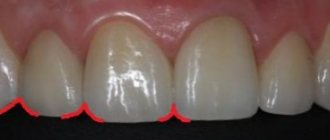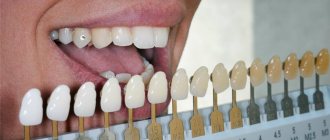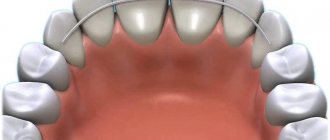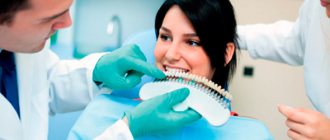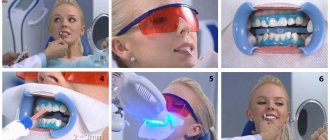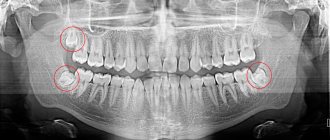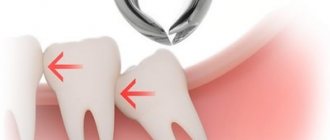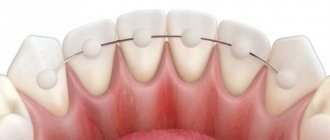Malocclusion and dental defects are problems that almost all people face, since only a few naturally have a perfect smile. Previously, such pathologies could only be corrected with the help of braces, and only in childhood and adolescence. Now the situation has changed dramatically. Thanks to the achievements of modern dentistry, everyone can get rid of malocclusion and other orthodontic pathologies, regardless of age.
Moreover, it is not even necessary to install braces, which makes many patients very happy. But it is worth remembering that straightening teeth without braces in adults will take much longer, since after 25 years the jaw bones have already completed their formation and will be difficult to respond to any orthodontic design.
Cases in which you can straighten teeth without braces
The braces system is the most effective, fastest and painless method for straightening crooked teeth, but many people refuse it for many reasons: they are embarrassed, afraid of discomfort or discomfort associated with eating or while talking.
But there are cases when a person can correct his bite without braces:
- Crooked teeth are only a couple of teeth, not an entire row, so there is no need to wear a complex system;
- The bite only slightly deviates from the norm, but if the bite is open, then braces are still necessary;
- A slight crooked tooth needs to be quickly corrected;
- A person with a “dental” problem is allergic to the metal components that are in braces;
- The gums are located too low, and there is a high probability of injuring them due to the locks of the brace system;
- The patient cannot or does not want to adhere to the rules of wearing and caring for braces;
- The patient wants to look perfect at work or in everyday life, so the use of braces in this case is excluded;
- The patient’s work involves clear and excellent diction (radio DJ, TV presenter, teacher), so he must refuse to wear braces.
In what cases can treatment be done without braces?
First of all, it should be noted that braces have been and remain the most effective in orthodontic treatment. And only in some cases you can do without their help:
· incorrect position of just one or two teeth (rotation, protrusion, retrusion, intrusion of crowns);
mild crowding of teeth;
· the presence of tremata and diastemas (wide dental spaces);
· widened or too narrow dental arch;
· slight deviations of bite from the norm;
allergy to metal;
· psychological discomfort and persistent reluctance to wear braces;
· high risk of injury to low-lying gums when installing braces;
· very low pain threshold;
· lifestyle or work specifics in which braces will interfere.
As can be seen from the indications, orthodontic structures such as aligners and trainers help only in cases where only light bite correction or elimination of small dental defects is required. Serious pathologies will still have to be corrected with braces. However, only a doctor can give a final conclusion on the advisability of using a particular method.
Aligners (aligners)
An aligner is a mouth guard made of silicone or soft plastic that exactly follows the contours of the teeth and works like a brace system, albeit slowly but effectively straightening the teeth. Despite the proven effectiveness of aligners, they are not used so often, mainly to correct bites.
The advantages of this method:
- Almost invisible on the teeth;
- Easy to remove while eating or brushing your teeth;
- Does not cause discomfort;
- There are no restrictions on food when wearing a mouth guard;
- Does not cause pain when wearing;
- You can treat “oral” problems while wearing a mouth guard;
- Do not cause allergies;
- Along with straightening, you can also whiten your teeth;
- Has no contraindications.
Disadvantages of this method:
- Not effective for complex problems;
- High price;
- Before eating, food must be removed prematurely and stored properly;
- Long production time (mouthguards are often delivered from abroad).
In order to comprehensively straighten crooked teeth using a mouth guard, you need to go through several stages. First, the dentist takes impressions of the teeth and creates an electronic model. The same layout is necessary at intermediate stages of treatment, as well as at the end of the procedure. For the entire stage of treatment, you need several drops, which should be changed after 2-3 weeks, as prescribed by the doctor.
The patient should wear the mouth guard at least 22 hours a day and remove it only to eat and brush teeth. The duration of treatment is from 6 to 8 months, and in case of prophylaxis.
Alignment methods for adults
Teeth straightening without braces in adult patients is used only in cases of uncomplicated pathologies. For example, the use of aligners - transparent trays made of polymer materials - allows you to correct the unevenness of the incisors and the density of the dentition.
To correct and disguise smile defects in adults, use:
- aligners;
- veneers and lumineers;
- prosthetics;
- restoration with composite materials.
At the same time, a corrective effect without unpleasant consequences is provided only by the use of aligners, the cost of a course of treatment of which in some cases is significantly higher than the price of a braces system. But even high-quality mouthguards will not help straighten teeth without braces for adults with serious pathology.
Teeth straightening with aligners
Aligners
- These are orthodontic aligners made of transparent polymers. Elastic but resilient supports placed over the upper and lower jaws that apply gentle pressure to guide the teeth into the correct position.
Aligners for teeth straightening
Teeth straightening with aligners occurs gradually and includes regular replacement of linings with denser ones. Each mouthguard is made individually based on the patient's orthodontic impressions.
Duration of treatment
depends on the complexity of the pathology and the type of aligners used. On average, it is 8-12 months of continuous - at least 20 hours a day - wearing the pads. If the expected correction time exceeds 1 year, then it is recommended to resort to teeth straightening with braces, as a faster and more effective method.
Types of aligners.
The effectiveness of treatment and its cost depend on the correct choice of an orthodontic mouth guard. Different manufacturers use their own technologies for producing aligners, and not all of them meet modern requirements. Therefore, when choosing devices, follow your doctor’s recommendations and give preference to certified products that have been tested and have real patient reviews.
Let's look at the most popular brands of orthodontic aligners used in Russian clinics:
Aligner Manufacturers
- Invisalign
is a development of Aling Technology (USA), the most experienced aligner manufacturer in the world. The mouthguard is manufactured using high-tech ClinCheck Pro software, which allows you to accurately predict the final result of therapy. With the help of this company's product there is a high probability of correcting severe malocclusions. The cost of a course of treatment, which involves replacing the lining every two weeks, ranges from 168 thousand rubles. - OrthoSnap
is an American company that produces more affordable aligners. Mouthguards are made from our own materials using Dynamic Physical Model technology without the use of computer modeling. Effective against minor defects such as diastema, crooked teeth. They do not allow you to predict the result. The cost of treatment with OrthoSnap aligners starts from 100 thousand rubles. - Star Smile
is a Russian analogue of American designs, produced by a young company. Uses 3D modeling programs, but does not have high manufacturing technologies. The use of aligners from this manufacturer gives good, predictable results in correcting minor defects in the anterior teeth. Due to the reduction in delivery costs, the price of treatment is lower than when using foreign aligners (from 80 to 160 thousand rubles). - Avantis 3D
is another Russian brand. In the production of aligners, we also use computer modeling and 3D technologies. This is one of the most affordable methods of treating jaw pathologies; the cost of treatment starts from 40 thousand rubles. But these mouthguards are not capable of correcting severe disorders.
The feasibility of treating malocclusion with aligners is assessed by an orthodontist. After all, even expensive high-tech mouth guards will not give the expected result in correcting severe pathologies.
Advantages of aligners:
- the ability to remove for eating and dental care;
- invisibility on teeth;
- do not cause allergies;
- do not injure the soft tissues of the oral cavity.
The main positive quality of the onlays is the ability to carry out usual oral hygiene, which significantly reduces the risk of caries.
Transparent aligners are almost invisible on the teeth
Cons of aligners:
- ineffective for severe disorders;
- have high treatment costs;
- cause discomfort when eating in public places;
- long production;
- unreliable fixation.
As we can see, the main disadvantage of the devices is the inability to correct complicated anomalies.
Price.
It directly depends on the chosen brand of aligners. Thus, treatment with Russian-made mouthguards will cost 40 thousand rubles or more, and the cost of using American high-tech developments reaches 280 thousand.
Veneers
Veneers
- These are overlays for teeth made of composite materials or porcelain. Designed to hide aesthetic smile defects.
Veneers are thin plates that are fixed to the outer surface of the teeth. Service life up to 10 years.
Veneers are coverings for teeth
Overlay thickness up to 0.5 mm. To make it look inconspicuous, the enamel is ground down by 0.3–0.7 mm.
It is impossible to straighten teeth with veneers. They are used to mask pronounced defects: chips, cracks, different heights of teeth.
Pros:
- invisible, as they are matched to the color of the patient’s enamel;
- short adaptation period, cannot be felt on the teeth just a few hours after installation;
- quick fixation procedure, instant results.
Veneers are matched to the color of tooth enamel.
Veneers easily cope with their task - masking unpleasant features of teeth, but do not solve problems with bite.
Minuses:
- the method requires grinding down the enamel;
- the need to repeat the procedure every 10 years or less;
- expensive treatment.
Veneers are used to correct minor defects. Plates are not able to hide pronounced abnormalities in the position of the teeth.
Price.
Installing one record costs 20 thousand rubles and more. The cost depends on the materials used and the complexity of the work.
Lumineers
Lumineers
– these are overlays on teeth, similar to veneers, but unlike the former, they have thin walls (up to 0.2 mm). Due to this difference, fixing the plates does not require cutting down the enamel.
Lumineers are ultra-thin veneers.
Teeth straightening with lumineers is similar in functionality to veneers - they mask smile defects.
Differences between lumineers and veneers.
The fundamental difference is the thickness of the plates, which is at least 2 times smaller for lumineers. This factor allows you to install onlays without grinding down your teeth, making their appearance natural. Lumineers produced using high-tech methods have greater strength and a service life that is twice as long as veneers.
Pros:
- do not require traumatic dental treatment;
- are made individually in a short time;
- do not lose their appearance throughout the entire period of operation;
- do not change tooth sensitivity;
- no different from other teeth.
If for some reason during the period of use it becomes necessary to remove the lumineer, this can be done without harm to the teeth.
Minuses:
- high cost of the record;
- They are not installed on large or strongly protruding teeth.
Price
for the installation of one lumineer from 30 thousand rubles.
Do not forget that with the help of onlays only the correction of external defects is possible, and not the treatment of pathology.
Composite dental restoration
Composite restoration
– a relatively inexpensive way to correct external tooth defects, in which, like filling, irregularities, chips, and stains on the enamel are masked using photocomposite materials.
Restoration of teeth using composite materials
During the work, the doctor first grinds the teeth and applies restoration material, drying each layer with a special lamp with UV radiation. The final layer is tinted to match the natural shade and polished. This technology is called tooth augmentation.
Pros:
- low cost;
- quick effect;
- aesthetics;
- does not require getting used to.
With the help of restoration, you can quickly return a damaged tooth to its correct shape.
Minuses:
- grinding down the tooth and removing the nerve (in some cases);
- service life up to 5 years;
- fragility;
- instability to dyes.
Depulpation (removal of the nerve) is a significant disadvantage of this procedure, as the tooth loses strength. This leads to premature tooth decay.
Price.
This correction method is distinguished by its accessibility. The cost of the procedure for 1 tooth is from 2,000 rubles.
It is impossible to straighten the bite of teeth with a composite material; using this method, part of the bone tissue is removed from the tooth in one place and built up in another, thereby improving the appearance.
Prosthetics with crowns
Dental prosthetics with crowns
– a radical way to correct your bite, which can give you the perfect smile... But at what cost?!
An artificial prosthesis can eliminate almost any external manifestations of malocclusion: curvature of teeth, different heights, gaps. However, this process is accompanied by high traumatism, since before the installation of crowns the enamel is strongly worn down, individual teeth are depulped (the nerve is removed). It turns out that the original, incorrectly positioned teeth are replaced with an ideal, but artificial smile.
Dental prosthetics with crowns
Types of crowns:
- metal ones - inexpensive, installed on the back molars, do not require much grinding of the enamel;
- ceramic – look as natural as possible, but fragile;
- metal-ceramic - strong, matched to the color of the teeth, but thicker, require strong grinding of the enamel;
- plastic ones are cheap, but very fragile and need careful care.
Ceramic crowns for teeth
Alignment of teeth with crowns is used to eliminate external defects and partially correct the bite.
Pros:
- quick results;
- individual production;
- aesthetic appearance.
Despite the positive aspects, the disadvantages of using this method to correct the bite are less pleasant.
Minuses:
- high price;
- the prosthetic procedure is irreversible, the teeth are ground down once and for all;
- Depulpation may be required.
Price:
Making a crown for one tooth costs from 6 thousand rubles. Prosthetic restoration of the front part of the teeth with metal-ceramic crowns costs 100 thousand rubles and more.
To summarize, we can draw the following conclusion:
Safe correction of malocclusion without braces in adults is only possible with the use of aligners, which gently return teeth to their correct position. If correction with mouthguards is not possible, it is recommended to install a brace system as the least traumatic method that allows you to preserve healthy teeth without grinding down the enamel and removing nerves.
Trainers
Trainers are a special device for straightening teeth, resembling a mouthguard. This method is as effective as aligners, but more affordable.
The advantages of this method:
- Can be used to straighten children's teeth;
- It will not only help straighten your teeth, but also relieve problems such as pacifier or finger sucking, improper breathing or tongue positioning;
- Helps straighten teeth for children and adults;
- Does not require constant use, overnight is enough;
- You can buy it yourself;
- With the help of trainers, you can correct problems with diction, malocclusion and abnormal tooth growth;
- Do not interfere with eating or talking;
- Do not require special maintenance;
- Low price.
Disadvantages of this method:
- Long treatment period - from a year or longer;
- At first wearing it causes discomfort;
- There is a possibility of the mouthguard falling out during night wear.
To completely correct crooked teeth, you need to go through three stages of treatment. At the first stage, soft blue trays are used. They promote habituation and prepare the dentition for harder structures. At the last stage, the patient uses retainers (a device for preventing the curvature of teeth), which is worn only at night and is a metal case that is fixed in the palate of the mouth and remains practically invisible.
Surgical teeth straightening
Surgery can only correct an abnormal bite, but not straighten the teeth. Surgical intervention is used only in cases where orthodontic treatment is ineffective.
Indications for surgical correction of malocclusion include noticeable skeletal deformities, such as abnormal jaw or chin size.
The operation is performed in a hospital under general anesthesia. Its duration depends on the complexity of the clinical case. After surgery, the patient undergoes a rehabilitation period. He will be able to return to a full life in 3-4 weeks.
Veneers
Veneers can also be used to hide minor crooked teeth. Veneers are thin plates of ceramic that are fixed to the teeth using a special glue.
The advantages of this method:
- Does not require a long period of treatment;
- Well hides small cracks, chips and yellow teeth;
- During the entire treatment period, the plates retain their snow-white appearance;
- The adhesive for fixation is absolutely safe, does not cause allergies and is odorless and colorless;
- Does not complicate daily oral care;
- Ceramic plates are very difficult to distinguish from real teeth.
Disadvantages of this method:
- They will not correct complex crooked teeth;
- There is a possibility of records splitting;
- Anesthesia is required during installation;
- Long wearing period;
- If there is tooth sensitivity, then this procedure is prohibited;
- If you have veneers, professional teeth cleaning or whitening is prohibited.
Massage for teeth straightening
Massage of the gums and palate is one of the most painless methods of comprehensive correction of dental anomalies. It is carried out while performing hygienic procedures for caring for the oral cavity. Massage in a circular motion along the gums using a medium-hard toothbrush.
As a result of such manipulations, local blood circulation will improve, pain will go away when wearing orthodontic structures, and the alignment process itself will go faster. Regular massage will strengthen your gums and prevent loosening of your teeth.
Increased sensitivity after the procedure
Many patients who have had their teeth filed complain of increased sensitivity, especially when eating hot and cold dishes and hard foods.
Dentists explain this phenomenon as follows. Dentin, located under the enamel, is penetrated by many tubules, inside of which nerve endings are located. As the thickness of the enamel decreases, pressure changes occur, which can cause pain when taking certain foods.
To reduce tooth sensitivity after the procedure, dentists recommend temporarily avoiding too hard foods, dishes with high and low temperatures, and acidic drinks.
During oral hygiene, you should use a brush with soft bristles and therapeutic and prophylactic toothpaste, rinses for sensitive teeth.
If sensitivity does not disappear a week after filing, you should contact your dentist.
Indications and contraindications for orthognathic surgery, recovery time.
In this article we will tell you how to install braces on crowns.
Follow the link https://orto-info.ru/ortodonticheskoe-lechenie/podgotovitelnyiy-period/informativnost-telerentgenogrammyi.html if you are interested in the importance of a teleroentgenogram in orthodontics.
Occlusion and the psychological state of a person
The standard of beauty is perfectly straight white teeth. Depending on how close a person’s smile is to the ideal, the attractiveness of a particular individual to others is determined. You can talk as much as you like about spiritual beauty, but it is often not possible to see it behind its repulsive appearance. Crooked teeth, a significant amount of deposits, and a pronounced decrease in the height of the crowns determine not only the attractiveness, but also the age of the patient. The worse the teeth, the older the person is in the perception of other people.
An unaesthetic appearance of a smile causes difficulties in interpersonal communication, a feeling of embarrassment, awkwardness, and the formation of psychological complexes. At the same time, there is no need to constantly worry about your own imperfections. If previously it was possible to correct a bite only in childhood and adolescence, now there are no restrictions for orthodontic correction. And now there is no need to even wear braces. Aligners can be used on patients of all ages.
Complications after filing teeth
If the manipulation is carried out in a dental office under the guidance of a qualified specialist, there is a small chance of a mild complication in the form of a temporary increase in sensitivity. All reviews of teeth filing prove that the side effect goes away quickly and does not cause concern.
To avoid any complications and side effects, you should not try to file your teeth at home. Attempts to use improvised tools to correct the dentition often cause chipping of enamel particles, the appearance of cracks and damage to several teeth at the same time. Successful and high-quality sharpening of teeth is possible only with diagnostics, professional dental instruments and therapeutic agents.
Alternative techniques
Mouth guards for bite correction
As an alternative to braces, the orthodontist may suggest a mouth guard to correct the bite in children over 17–18 years of age. With their help, it is possible to correct defects in the upper dentition and correct the bite on the lower jaw in children.
Myotherapy
Another alternative option for correcting malocclusion in children is myotherapy. The essence of this technique is to perform special exercises to correct the bite in children. As a result of regular training, the muscular system begins to work correctly, and the teeth are aligned. The peculiarity of this method is that it can be used both as an independent and as an additional means for correcting dental defects. It is suitable for children no older than four years old, so it is impossible to do without the supervision of an adult during the exercises.
However, myomotherapy is not suitable for every child, as it has the following contraindications:
- impaired mobility of the jaw arch;
- muscle hypertrophy;
- severe dental anomalies;
- deformation of the maxillofacial system after illness or injury.
Surgery
Surgery also applies to correcting malocclusions without braces in older children, but this method is not common and is used as a last resort. Correction of malocclusion in children under 12 years of age by surgery, as a rule, is carried out only for special indications. These include the following defects:
- congenital malformation of the jaw;
- facial asymmetry;
- chin dysplasia;
- skeletal abnormalities;
- deformation of the cranial vault.
In all other cases, the specialist will try to solve the problem in a less radical way, for example, with braces or prosthetics.
Second method. Microprosthetics with veneers and lumineers
In fact, this option differs from the first (artistic restoration) in better quality, durability, improved aesthetics and, accordingly, a higher price. But it also allows for the correction of several frontal crooked teeth in adults without braces only if the pathology is minor and the maxillofacial apparatus is functioning normally.
Microprosthetics and artistic extensions are methods that do not treat the bite, but allow you to comprehensively hide all external defects of the smile area (ugly enamel color, irregular shape and size of the crown, old fillings and chips). If the patient has a serious bite pathology, then the linings will only aggravate the situation, and they will not last long, since they can quickly break due to improperly distributed load.
The photo shows the installation of veneers
Correcting one crooked tooth without braces can be done with veneers. However, if you really want to install more aesthetic and durable “Hollywood” lumineers, then you need to keep in mind that such overlays will have to be installed comprehensively, that is, immediately over the entire smile zone (6-8 front units). The decision to install lumineers will cost much more, but the originals are created only in the USA, they are snow-white and so thin that there is practically no need to grind the enamel before installation. But with veneers, hard tissue will have to be prepared, and this process will be irreversible.
When does a child need to have their bite corrected?
Parents should note all important details in the child’s unconscious behavior. Pay attention to how the child breathes, whether his mouth is often open, whether he snores in his sleep, what position the lower jaw is in, whether he likes to gnaw hard objects - these factors have a huge impact on the development of dental pathologies. Take a closer look at the posture and structure of the foot, these are also important indicators of possible violations. Did you find any deviations? Consult a professional.
Risk factors
- difficulties with nasal breathing, for example, due to adenoids or allergies;
- spinal column deformity;
- bad habits;
- genetic predisposition to dental anomalies;
- diseases of the central nervous system.
If the listed risk factors are present, treatment will be effective only with the participation of doctors from related fields. Therefore, it is best to contact myofunctional centers, which unite orthopedists, pediatric dentists, orthodontists and osteopaths. The joint work of specialists guarantees accurate diagnosis and successful resolution of the issue.
Orthodontist consultation
Orthodontist O.A. At the first consultation, Baranova conducted a thorough examination, during which she revealed the absence of the 34th tooth (lower left), a shift to the left (towards the missing tooth) of the center of the lower dentition, a deep bite and crowded teeth. The primary treatment plan (which was refined after an in-depth diagnosis) included the following points: correction of the bite, elimination of crowding of teeth, preparation of a site for an implant in the area of the 34th tooth. The orthodontist suggested that the patient undergo further comprehensive treatment at Dial-Dent, namely, installation of an implant and prosthetics on the implant. The patient refused implantation and prosthetics, as she was going to undergo this stage at her place of residence. However, the plan drawn up by the orthodontist took into account subsequent dental prosthetics.
For accurate calculations, you need to undergo an in-depth diagnosis (photographs of OPTG and TRG in the lateral projection, taking impressions, photometry, consultation with an osteopath).
In the panoramic photograph of the teeth (photo below), the arrow shows the location of the missing tooth, which will be replaced with a dental implant after orthodontic treatment.
Photometry before treatment:
Surgical bite correction
Another way to correct the position of teeth in the jaw is to perform orthognathic surgery, during which the size and position of the jaws are changed. The operation is preceded by a period of wearing braces. The orthodontic structure will have to be worn for a certain time even after the intervention.
Surgery is indicated for patients only in extreme cases when braces as an independent method of correction cannot correct the patient’s anomaly. The intervention is performed in a hospital setting as planned after a period of preliminary preparation. You will have to spend several weeks in a hospital bed, since the recovery period is quite difficult and the patient requires constant medical supervision.
Price
The cost of filing teeth depends on the reasons for which it is carried out and what result is needed to achieve:
- preparation for caries - from 200 to 350 rubles per row element;
- treatment of enamel after removing braces – 550-650 rubles;
- identification of traumatic occlusion and grinding of one tooth – 200-300 rubles;
- cutting down a tooth for a crown – 130-200 rubles;
- filing a molar under an orthodontic structure – 150-200 rubles.
Find out how teeth are prepared in the video.
How is the condition of your teeth related to your overall health?
While a person is young, his body has a significant “margin of safety”, thanks to which many problems are in a state of compensation for a long time. At the level of the oral cavity, the incorrect position of the teeth is compensated by changes in the tone of the masticatory muscles, increasing the load on the joints of the lower jaw and periodontal tissue. With age, teeth that are positioned incorrectly on the jaw begin to wear out and decay faster, increasing the likelihood of developing periodontal disease, their loosening and loss.
Insufficiently thorough chewing of food reduces the efficiency of the digestive system. Crowding and mismatch of the chewing surfaces of the antagonist teeth of the upper and lower jaws contribute to the accumulation of bacterial plaque and the rapid development of caries. Changes in the tone of the facial muscles and incorrect position of the jaws relative to each other have a negative impact on posture. Damage to the temporomandibular joint can cause chronic headaches.
Artistic restoration of teeth
If there is no time or opportunity to fix a defect, it can be disguised. It is not advisable to put on braces or spend money on a set of aligners for the sake of 1-2 crooked teeth. You can change the appearance of dental crowns using composite materials. In this way, you can remove scars and diastemas, visually lengthen your teeth, and correct the cutting edges of your teeth.
Artistic restoration can also be used after treatment with orthodontic structures in order to bring the result to perfection, cover areas of enamel damage when removing locks, and disguise other defects.
As you can see, braces are not the only way to achieve a perfect smile. They are not suitable for everyone and not everyone needs them. To choose the most effective way to eliminate defects in the dentition, you can contact an orthodontist and listen to his opinion.
How much does it cost to correct malocclusion in children?
Correcting a bite in young children cannot be called expensive. Doctors use simple and inexpensive orthodontic appliances or recommend exercises. But an older child requires more serious treatment, and accordingly, the cost will be slightly higher. The cost of treatment depends on the severity of the pathology and the age of your child. The price of correcting defects with a plate or trainers for a 5-year-old child will vary from 3,000 to 6,000 rubles. Installing braces for children over 12 years of age will cost 100,000 - 300,000 rubles. Treatment with aligners, costing from 169,000 rubles, is available to adolescents aged 16–17 years.
Any dental correction in children should begin with a thorough examination. Correct and timely identification of problems makes it possible to eliminate dental anomalies in almost all patients. The success of treatment depends mainly on its timeliness. The sooner parents show their child to a professional, the greater the chance of eliminating the defect.
Exercises to correct bite in children
The orthodontist selects exercises to correct the bite individually for each child, taking into account the structural features of the jaw and the severity of the pathology. Myogymnastics can be performed by parents themselves, who have learned the technique from a specialist, or by teachers and nurses in groups of children with the same disabilities.
- The lesson includes several exercises for the muscles of the tongue and oral cavity.
- Hold a sheet of cardboard with your lips while breathing through your nose.
- Move your lower jaw forward, biting your upper lip with your teeth.
- Pull out your lips with a tube.
- Puff out your cheeks with your lips closed.
- Massage your lips.
- “Click” your tongue.
- Touch each tooth with your tongue one by one.
- Hold some water in your mouth while breathing through your nose.
Myogymnastics must be performed daily at the same time until fatigue appears, taking short breaks between exercises. Only in this case will it be effective and bring the expected results.
